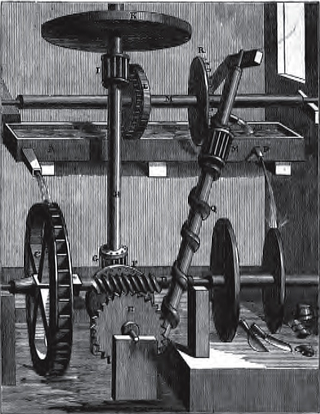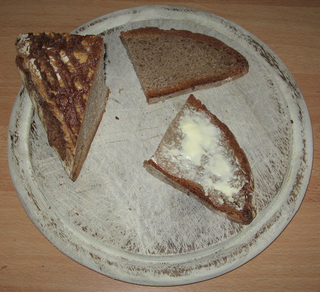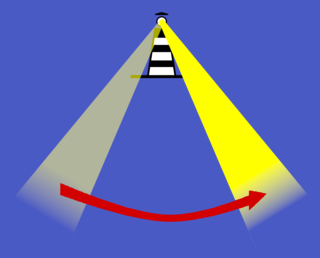Zeno's paradoxes are a series of philosophical arguments presented by the ancient Greek philosopher Zeno of Elea, primarily known through the works of Plato, Aristotle, and later commentators like Simplicius of Cilicia. Zeno devised these paradoxes to support his teacher Parmenides's philosophy of monism, which posits that despite our sensory experiences, reality is singular and unchanging. The paradoxes famously challenge the notions of plurality, motion, space, and time by suggesting they lead to logical contradictions.

Perpetual motion is the motion of bodies that continues forever in an unperturbed system. A perpetual motion machine is a hypothetical machine that can do work infinitely without an external energy source. This kind of machine is impossible, since its existence would violate the first and/or second laws of thermodynamics.

Leopold "Butters" Stotch is a fictional character in the adult animated television series South Park. He is loosely based on co-producer Eric Stough and his voice is provided by co-creator Matt Stone. He is a student at South Park Elementary School.

The history of perpetual motion machines dates at least back to the Middle Ages. For millennia, it was not clear whether perpetual motion devices were possible or not, but modern theories of thermodynamics have shown that they are impossible. Despite this, many attempts have been made to construct such machines, continuing into modern times. Modern designers and proponents sometimes use other terms, such as "overunity", to describe their inventions.

The Sutro Baths was a large, privately owned public saltwater swimming pool complex in the Lands End area of the Outer Richmond District in western San Francisco, California.

Doctor Fun is a single-panel, gag webcomic by David Farley. It began in September 1993, making it one of the earliest webcomics, and ran until June 2006. Doctor Fun was part of United Media's website from 1995, but had parted ways by 2003. The comic was one of the longest-running webcomics before it concluded, having run for nearly thirteen years with over 2,600 strips. The webcomic has been compared to The Far Side.
Aerial techniques, also known as "high-flying moves" are performance techniques used in professional wrestling for simulated assault on opponents. The techniques involve jumping from the ring's posts and ropes, demonstrating the speed and agility of smaller, nimble and acrobatically inclined wrestlers, with many preferring this style instead of throwing or locking the opponent.

Schrödinger's cat is a thought experiment, usually described as a paradox, devised by Austrian physicist Erwin Schrödinger in 1935. It illustrates what he saw as absurdities in the views that other physicists had about quantum mechanics, by applying them not to microscopic objects but to everyday ones. The thought experiment presents a cat that might be alive or dead, depending on an earlier random event. In the course of developing this experiment, he coined the term Verschränkung (entanglement). It was not long before science-fiction writers picked up this evocative concept, often using it in a humorous vein. Works of fiction have employed Schrödinger's thought experiment as plot device and as metaphor, in genres from apocalyptic science fiction to young-adult drama, making the cat more prominent in popular culture than in physics itself.
Cartoon pornography, or animated pornography, is the portrayal of illustrated or animated fictional cartoon characters in erotic or sexual situations. Animated cartoon pornography, or erotic animation, is a subset of the larger field of adult animation, not all of which is sexually explicit.
James Davis Nicoll is a Canadian freelance game and speculative fiction reviewer, former security guard and role-playing game store owner, and also works as a first reader for the Science Fiction Book Club. As a Usenet personality, Nicoll is known for writing a widely quoted epigram on the English language, as well as for his accounts of suffering a high number of accidents, which he has narrated over the years in Usenet groups like rec.arts.sf.written and rec.arts.sf.fandom. He is now a blogger on Dreamwidth and Facebook, and an occasional columnist on Tor.com. In 2014, he started his website, jamesdavisnicoll.com, dedicated to his book reviews of works old and new; and later added Young People Read Old SFF, where his panel of younger readers read pre-1980 science fiction and fantasy, and Nicoll and his collaborators report on the younger readers' reactions.

In German cuisine, Butterbrot is a slice of bread topped with butter. It is still considered Butterbrot even if additional toppings such as cheese, spreads, or lunch meats are added, as long as it begins with a slice of bread with butter.

The cat righting reflex is a cat's innate ability to orient itself as it falls in order to land on its feet. The righting reflex begins to appear at 3–4 weeks of age, and is perfected at 6–9 weeks. Cats are able to do this because they have an unusually flexible backbone and no functional clavicle (collarbone). The tail seems to help but cats without a tail also have this ability, since a cat mostly turns by moving its legs and twisting its spine in a certain sequence.

JavaFX is a software platform for creating and delivering desktop applications, as well as rich web applications that can run across a wide variety of devices. JavaFX has support for desktop computers and web browsers on Microsoft Windows, Linux, and macOS, as well as mobile devices running iOS and Android, through Gluon Mobile.
A Usenet personality was a particular kind of Internet celebrity, being an individual who gained a certain level of notoriety from posting on Usenet, a global network of computer users with a vast array of topics for discussion. The platform is usually anonymous, although users can get celebrity status, usually by being deemed different from other posters in some way.

A Lifetime of Temporary Relief is a box set by Duluth, Minnesota group Low, released in 2004. The set includes a two-sided DVD containing documentaries, videos and live tracks.

Toast is sliced bread that has been browned by radiant heat. The browning is the result of a Maillard reaction altering the flavor of the bread and making it firmer. The firm surface is easier to spread toppings on and the warmth can help butter reach its melting point. Toasting is a common method of making stale bread more palatable. Bread is commonly toasted using a toaster or a toaster oven. Toast may contain acrylamide caused by the browning process, which is suspected to be a carcinogen. However, claims that acrylamide in burnt toast causes cancer have not been proven.
Project Wonderful was an advertising service created by programmer and webcomic author Ryan North in late 2006. Headquartered in Toronto, Ontario, the service supported thousands of webcomics and blogs with auctioned online advertisements, until it was shut down in 2018.

The buttered toast phenomenon is an observation that buttered toast tends to land butter-side down after it falls. It is used as an idiom representing pessimistic outlooks. Various people have attempted to determine whether there is an actual tendency for bread to fall in this fashion, with varying results.

The lighthouse paradox is a thought experiment in which the speed of light is apparently exceeded. The rotating beam of light from a lighthouse is imagined to be swept from one object to shine on a second object. The farther the two objects are away from the lighthouse, the farther the distance between them crossed by the light beam. If the objects are sufficiently far away from the lighthouse, the places where the beam hits object 2 will traverse the object with an apparent speed faster than light, possibly communicating a signal on object 2 with superluminal velocity, which violates Albert Einstein's theory of special relativity.

Seastar Bakery was a bakery in Portland, Oregon, United States. Annie Moss and Katia Bezerra-Clark owned and operated the business, which shared a space with Handsome Pizza in northeast Portland's Vernon neighborhood starting in 2015. Seastar served breads, cookies, pastries, and toast, among other baked goods. Despite garnering a positive reception and being deemed one of the city's best bakeries by Eater Portland and Portland Monthly, Seastar closed in August 2022.













